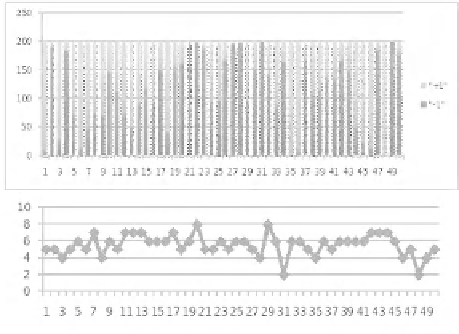Information Technology Reference
In-Depth Information
Fig. 5.
Opposite of identity
Let's now consider a group of
n
=8
agents. The initial convictions of agents relative
to both alternatives are considered as variates:
50
random drawings of these
8
initial
probabilities have been carried out. For each of these
50
initial conviction vectors, the
order of agents' intervention in the debate can then be considered:
200
permutations are
randomly selected (among the
8!
possible rankings) for each initial conviction vector.
Each of the four elementary illustrations has been plotted in the following figures
(i.e. one for each
B
function). For each of the 50 initial conviction vectors selected
randomly, a bar represents the number of
+1
and
−
1
outcomes (light gray for
+1
and
dark gray for
1
).
Each figure is to be associated with the maximum number of rounds required to
achieve the ground decision for each initial conviction vector. In the proposed simula-
tions, this number does not exceed 8 rounds in any of the cases chosen for
B
.
The indifference threshold is
=0
.
01
for any agent. Agents speak in turn according
to the order generated by the 200 permutations, upon the condition that they are able to
express a clear opinion, specifically: agent
a
j
can speak if
−
|c
a
j
− c
a
j
|≥
.
For the same initial conviction vector, it can be observed that for each function
B
,
the outcome of the debate may depend on the order the agents intervene in the debate.
This type of situation can be interpreted as a weak expression of preferential contexts,
whereby any perturbation is able to change the debate outcome. From this point of view,
influence function
B
is a disturbance function for this dynamic model of a debate. As
a consequence, simulations allow verifying that the order the agents intervene in the
debate and their influence are both decisive variables with regard to the convergence of
conviction state equations.
The social influence of an agent may thus be considered as a disturbance in the de-
liberation process, except if it is relevantly used by the debate manager to guide the
discussion. In this latter case, social influence can be viewed as an actuator that enables
controlling the debate outcome or at least accelerating its convergence. For example,
when the debate outcome is practically certain (i.e. the bar is almost completely light
or dark gray), then the simplest control might consist of choosing the order of agents

